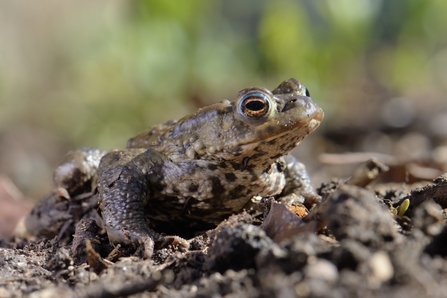
Common toad by Nick Upton
In Suffolk, out of 22,000 non garden ponds, about 70% have been neglected and become choked with leaf litter and silt. With many more lost to agricultural intensification and urban development the refuge provided by gardens and school grounds has become increasingly important.
By welcoming amphibians into your garden, not only are you helping wildlife, you are also introducing a very effective form of 'pest' control - frogs, toads and newts will munch through scores of slugs, snails and other small insects considered a nuisance by gardeners.
Species
Britain has two native frogs and two toads, and three species of newts. Of these, the common frog and common toad are likely to be found in gardens throughout Britain. The common or smooth newt and the palmate newt are also widely distributed, while some ponds may even contain the scarce great crested newt.
In the south east of England it is possible that non-native green marsh frogs visit gardens, while species like the natterjack toad and pool frog are extremely unlikely to be seen in a garden environment.
Building a pond
One of the aims of Living Gardens is about trying to create essential corridors for wildlife to move between habitats. In the same way, a series of ponds in a neighbourhood creates a vital link for amphibians to move through our fragmented landscape.
Although, of course, it is preferable to have a large pond – a small pond (even a sunken sink) is better than no pond at all.
If you can try and make sure your pond has at least one side of the pool that gradually slopes up to dry land. This enables the young amphibians to leave the water in mid-summer once the tadpole stage is over.
When in the pond, frogs and toads need a point above the water on which to rest and breathe. In the summer a water lily pad may suffice but a more permanent solution is to position a few rocks or logs half in and half out of the water if there are no suitable areas of shallow water.
If your pond has steep sides, you could always fit a ramp covered in chicken wire in one corner.
Newts are probably the most aquatic of British amphibians. Attract them by allowing grass to grow over the pond edge into the water and introducing non-invasive submerged aquatic plants. Newts use narrow-leaved water plants on which to lay their eggs, placing each egg between a folded leaf.
Allow new ponds to become colonised naturally by amphibians likely to be already present in the area, rather than transferring spawn or tadpoles. Transferring spawn or tadpoles from other ponds runs the risk of spreading diseases, such as red leg disease of frogs, or introducing invasive pond weeds that can quickly choke the pond with vegetation.
The introduction of fish into wildlife ponds is generally not advised, as they can eat smaller animals, including spawn and mayfly larvae. It is recommended that fish are only introduced into wildlife ponds larger than 10,000 litres (4x2m) and then only one fish per two square metres of surface area.
It is also important to link your pond to other garden features. The best Living Gardens contain a mosaic of habitats that species can move through easily and utilise. Having long grass, bushes or piles of logs or rocks will provide shelter for amphibians and link to these other non-water habitats.
Check out our section on Garden ponds for wildlife for more detailed information on building and stocking your pond.
Logpiles, leaves and compost
As suggested above, attracting amphibians into your garden is not just about digging a pond. In the autumn, amphibians will look for suitable sheltered places where they can hibernate until the spring.
Log piles provide good shelters but frogs, toads and newts will also find suitable places in hedge bottoms, compost heaps and under stones.
Allowing fallen leaves to remain on lawns can provide a place for frogs to hibernate, while also providing homes for invertebrates.
Amphibians will also hibernate in the silt at the bottom of ponds, so make sure you only de-silt once every five years and before the hibernating process has begun.
Health and Disease
For information on causes of frog mortality including spawn failure, tadpole loss and disease in adult frogs please see the Froglife website.
Legislation
Our native amphibia have been protected by the Wildlife and Countryside Act 1981. All amphibians are given some protection, but the natterjack toad and great crested or warty newt have been given special protection.
Unless you have a licence, it is illegal to offer for sale (which includes hire, barter or exchange) any amphibians. With the specially protected species, it is illegal to kill, injure or catch or attempt to do these things; or to have in your possession (unless legally obtained); or to sell; or to damage, destroy or obstruct any place being used for shelter or protection; or to disturb these animals.
If you are found doing any of these things there is a fine of up to £1,000 for each animal involved. There are exceptions for accidental killings and for situations which could not reasonably have been avoided.
